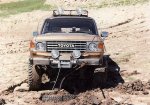rruff
Explorer
Rig: 2018 TRD Off-Road tacoma 4x4 with the stock e-locker.
This is one area where I don’t exactly know how much or what recovery gear I need.
I overlanded for 13 years in a 2wd Toyota pickup. I think you are in good shape. And I was alone most of the time (just me) and no one knew where I was for months at a time. Usually camped far from any humans. The wilderness is really not dangerous unless you are stupid.
Recovery gear was an air compressor, camp shovel, tire plugs, and a nylon rope. I used the air compressor a lot, the shovel and plugs several times, and the rope twice (once for me, once for someone else). I'd recommend a good compressor in addition to a cheap one.
Most important IMO is to make sure you always have at least a couple days of drinking water on board if you are in the desert. That's about it.

